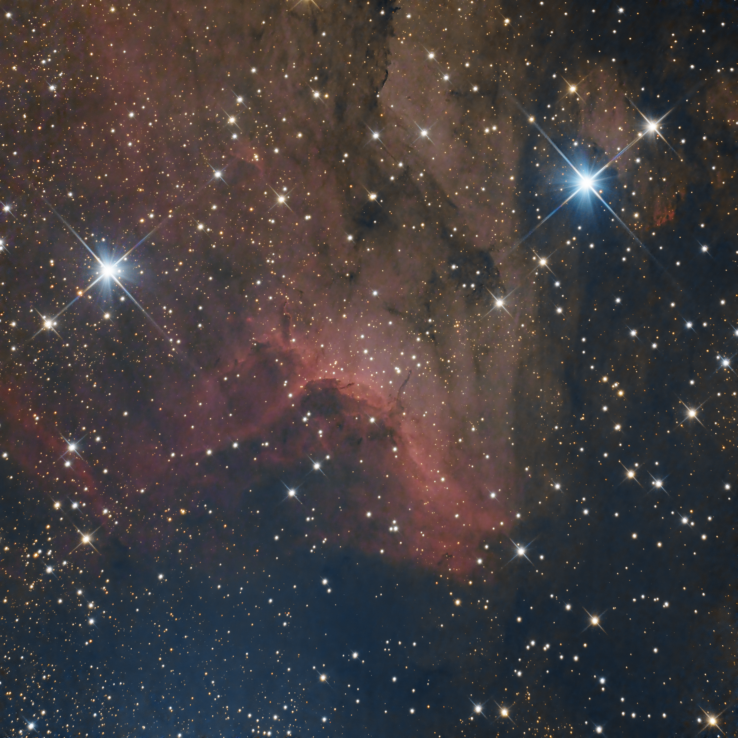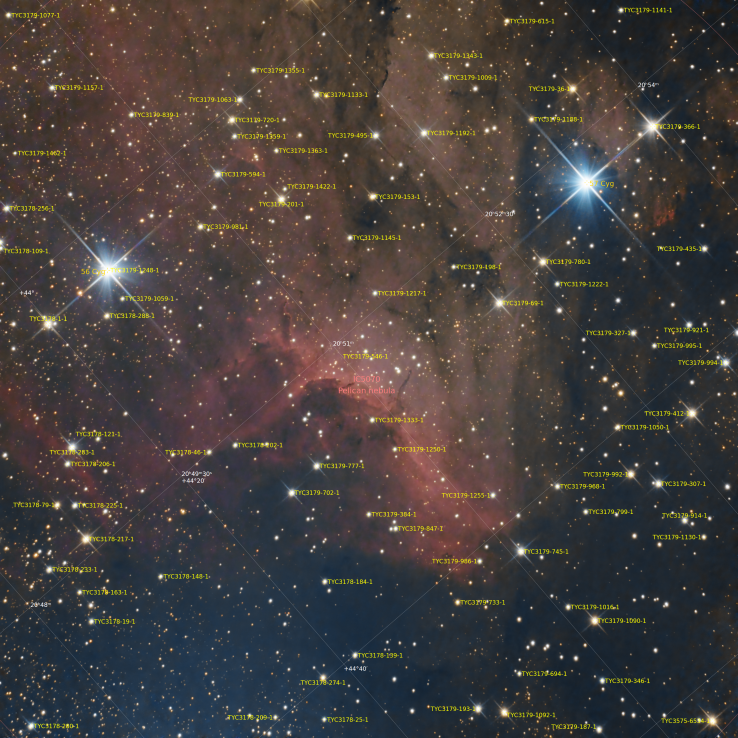IC5070 Pelican Nebula OSC 2022 ASI533 130PDS
Two years after building a concrete pier to save time while on vacation to the summer house, time and work permitted for some astrophotography fun!
The Pelican nebula was imaged on two consecutive nights (30-31 August 2022) for a total of 8ish hours of integration over two nights.
Having abstained from astrophotography for quite some years, I started taking subframes of NGC7000 thinking I was in the pelican for some hours the first night :P
The IC5070 Pelican Nebula is a breathtakingly beautiful astronomical object located in the constellation Cygnus. This stellar nursery is a cloud of gas and dust that has been illuminated by the light of young, hot stars embedded within it, creating a stunning display of vivid colors and intricate shapes.
The nebula's name comes from its resemblance to a pelican, with its long "bill" and "head" clearly visible. The pelican's "body" is a bright cloud of ionized gas, glowing pink and orange due to the ionization of hydrogen atoms by the ultraviolet radiation from the young stars.
Stretching out from the pelican's "body" are tendrils of gas and dust, twisted and sculpted by the powerful winds and radiation from the young stars. These tendrils are rich in complex organic molecules, including amino acids and sugars, which are the building blocks of life.
In addition to its stunning beauty, the IC5070 Pelican Nebula is also an important site for the study of star formation. The young stars within the nebula are still in the process of accreting material from their surrounding gas clouds, and their powerful radiation and winds are shaping the environment around them, potentially triggering further star formation.
Overall, the IC5070 Pelican Nebula is a fascinating and visually stunning object that offers a glimpse into the dynamic processes of star formation and the origins of life in the universe.
The Pelican Nebula (also known as IC 5070 and IC 5067) is an H II region associated with the North America Nebula in the constellation Cygnus. The gaseous contortions of this emission nebula bear a resemblance to a pelican, giving rise to its name. The Pelican Nebula is located nearby first magnitude star Deneb, and is divided from its more prominent neighbour, the North America Nebula, by a foreground molecular cloud filled with dark dust. Both are part of the larger H II region of Westerhout 40.
The Pelican is much studied because it has a particularly active mix of star formation and evolving gas clouds. The light from young energetic stars is slowly transforming cold gas to hot and causing an ionization front gradually to advance outward. Particularly dense filaments of cold gas are seen to still remain, and among these are found two jets emitted from the Herbig–Haro object 555.
Millions of years from now this nebula might no longer be known as the Pelican, as the balance and placement of stars and gas will leave something that appears completely different!
Imaging Telescopes Or Lenses : Sky-Watcher Explorer 130PDS
Imaging Cameras : ZWO ASI533MC
Mounts : Sky-Watcher NEQ6-Pro
Filters : ZWO UV IR CUT 1.25"
Accessories : DIY Motorized Focuser
Software : Pleiades Astrophoto PixInsight · Stefan Berg Nighttime Imaging 'N' Astronomy (N.I.N.A. / NINA)
Guiding Telescopes Or Lenses : Sky-Watcher 9x50 Finderscope
Guiding Cameras : QHYCCD QHY5
Aug. 30, 2022, Aug. 31, 2022
Frames: 1061×60″(8h 50′ 30″′)
Integration: 8h 50′ 30″
Avg. Moon age: 3.03 days
Avg. Moon phase: 10.04%
Basic astrometry details
Astrometry.net job: 7444128
RA center: 20h51m05s.5
DEC center: +44°23′16″
Pixel scale: 1.186 arcsec/pixel
Orientation: 220.249 degrees
Field radius: 0.701 degrees
Resolution: 3008x3008
File size: 10.8 MB
Locations: Amarynthos obs, Amarynthos, Evia, Greece

